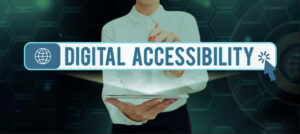7 Steps to Digital Accessibility for Nonprofits

In today's fast-paced world, technology is a crucial tool for nonprofits to connect with donors. The digital landscape, from fundraising platforms to social media, offers vast potential for outreach and impact.
However, amidst these advancements, digital accessibility* is often overlooked. These 7 tips, can make nonprofit platforms accessible, inclusive, and more engaging, fostering a stronger philanthropic community.
Improve your nonprofit organization’s digital accessibility with these 7 tips.
1. Increase Your Understanding of Digital Accessibility
Digital accessibility refers to the practice of designing websites, applications, and digital content in a way that enables all individuals, including those with disabilities, to perceive, understand, navigate, and interact with them effectively. For nonprofit professionals, this means creating an online presence that is welcoming to people with diverse abilities, including those with visual, auditory, motor, and cognitive impairments.
2. Adopt Inclusivity
By prioritizing accessibility, nonprofits convey a strong message of inclusion, compassion, and equality. Digital accessibility should not be treated as an optional add-on but as essential for fostering inclusivity within the nonprofit sector. Just as physical spaces must be accessible to all, the same standard should apply to the digital realm.
3. Address Common Accessibility Barriers
Understanding the challenges individuals with disabilities face is key to addressing accessibility barriers. Common issues include:
Visual Impairments: Ensure websites are screen reader-compatible, use descriptive alt text for images, and maintain clear navigation.
Hearing Impairments: Provide accurate captions and transcripts for videos and audio content.
Motor Impairments: Design websites and forms with keyboard navigation for those who cannot use a mouse or touchscreen.
Cognitive Impairments: Simplify layouts, use plain language, and avoid flashing animations to enhance accessibility.
4. Collaborate with Donors and Advocacy Groups
To best understand the diverse needs of all their stakeholders (donors, volunteers, and clients), nonprofits should actively engage with individuals and advocacy groups representing various disabilities. Feedback from these communities will provide valuable insights into potential improvements for digital accessibility.
5. Prioritize Web Accessibility Compliance
Many countries have introduced web accessibility laws and guidelines to ensure digital content is accessible to all citizens. Nonprofits must stay informed about these regulations and work toward meeting or exceeding the required accessibility standards.
For organizations based in the United States, the W3C Web Accessibility Initiative provides a comprehensive look on best practices for web accessibility.
6. Conduct Regular Accessibility Audits
Conducting regular accessibility audits of digital platforms helps identify and rectify potential barriers. These audits can be carried out by internal staff or external consultants with expertise in web accessibility. This will ensure things like accessible and inclusive website design, functionality, and structure are in place to remove any barriers affecting individuals.
7. Train Staff and Volunteers
Training staff and volunteers on digital accessibility empowers the entire team to create an inclusive online environment.
In this digital age, accessible platforms help nonprofits build meaningful connections with donors. Embracing accessibility aligns with most nonprofits’ values of compassion and inclusivity, strengthens donor relationships, and broadens the donor base. By fostering accessibility, nonprofits ensure everyone can fully engage in the philanthropic journey.
Let’s champion accessibility as a cornerstone of modern nonprofit values.
Here are a few resources to help you get started:
Web Content Accessibility Guidelines (WCAG): the source of truth for all things relating to digital accessibility standards.
The A11y Project: a collection of community-sourced resources for web accessibility.
Deque Systems: a wealth of resources such as webinars, articles, and checklists to help organizations improve their accessibility efforts.
WAVE Web Evaluation tools: free and easy evaluation tool/browser extension that helps organizations make their web content more accessible.
Accessible Brand Color tools: this easy-to-use color checker from Use All Five can quickly tell you which of your brand colors are ADA-compliant when paired together. The outcome can help guide your online and offline text color choices.
* This year marks the 34th anniversary of the Americans with Disabilities Act (ADA). The ADA prohibits discrimination against individuals with disabilities in various areas, including employment, public accommodations, transportation, and telecommunications. Today, the ADA has a significant impact on mandating digital content and services that are accessible to people with disabilities.
NOTE: Meghan Sharon and Amanda Swadlow of TrueSense Marketing, along with Sandy Shin, VP of Communications at The Braille Institute presented Accessibility by Design: Breaking Barriers by Crafting Inclusive Donor Experiences at the 2024 Bridge Conference. In this article, Meghan shares actionable improvements every nonprofit can adopt to be sure their mission and message is inclusive and barrier-free for all.
 Guest blog by: Meghan Sharon, Senior Digital Strategist, TrueSense Marketing. Meghan is a digital and multichannel marketing professional at TrueSense Marketing, with nearly a decade of experience in nonprofit and agency settings. Over the years, she has partnered with humanitarian, animal welfare, higher education, medical, and veterans’ organizations to embrace the omnichannel world we live in and develop effective fundraising programs for their worthy missions.
Guest blog by: Meghan Sharon, Senior Digital Strategist, TrueSense Marketing. Meghan is a digital and multichannel marketing professional at TrueSense Marketing, with nearly a decade of experience in nonprofit and agency settings. Over the years, she has partnered with humanitarian, animal welfare, higher education, medical, and veterans’ organizations to embrace the omnichannel world we live in and develop effective fundraising programs for their worthy missions.